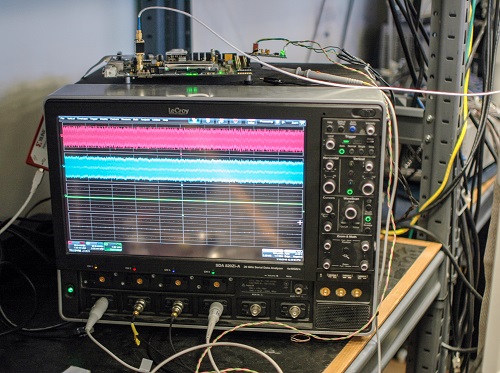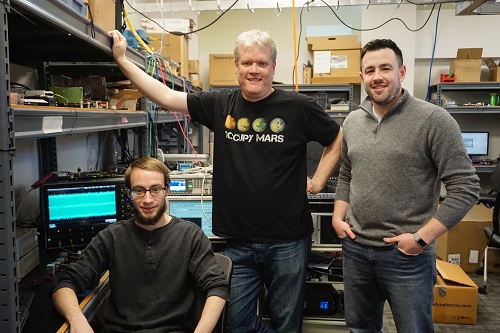BY MARTIN ROWE, Senior Technical Editor, Test & Measurement
EDN and EE Times
www.edn.com , www.eetimes.com
When you connect Ethernet, Wi-Fi, data storage, broadband, or many other devices to each other, there’s a good chance that it works because of the University of New Hampshire Interoperability Lab (UNH-IOL). Located in Durham, the UNH-IOL’s engineering staff and students develop test plans, design hardware, and write embedded code and applications for testing many communications links. Often, the lab is the first to develop test tools, which then become adopted as the standard for interoperability and compliance testing.
To learn how UNH-IOL works with silicon and test manufacturers, Electronic Products visited the lab on Dec. 18, 2017. Chief Engineer Bob Noseworthy and Ethernet Technologies Senior Manager Curtis Donohue explained how the lab works, with a focus on automotive Ethernet.
The UNH-IOL is a self-funded, independent testing lab affiliated with the university. Member companies who use the lab’s equipment and testing services and attend plugfests pay an annual fee. The lab also produces test reports for member companies to show standards compliance to their customers.
While many of the lab’s clients are semiconductor companies looking to test their latest silicon, other companies such as cable manufacturers also join. Test-equipment and networking-equipment companies also play a role, often donating their products to the lab. The lab’s large array of networking equipment lets member companies test for backward-compatibility.
Before there is test equipment
Because many of the lab’s clients design ICs for emerging technologies, there’s often no test equipment commercially available. Thus, the UNH-IOL often develops its own test hardware and software. Under staff supervision, students often develop the software based on test plans. Once tools are in operation, the students use them to test customer products.
“The test plan shapes how we develop a test tool and what it needs to do,” said Noseworthy. “Member companies come to plugfests or work with us to validate the test plan, interoperability tests, and conformance test tools. Members often duplicate our hardware and use our software in their labs.”
Automotive Ethernet
Because automakers are incorporating Ethernet into vehicles, the UNH-IOL is involved in developing new standards, test tools, and test plans. Automotive Ethernet running at 100 Mbps soon won’t be fast enough to move data from the ever-increasing number of sensors and cameras in vehicles. Autonomous and driver-assisted vehicles rely on these devices. Connecting each with its own pair of wires isn’t feasible because of cost and weight constraints. That’s why 1000BASE-T1 (IEEE 802.3 bp) products are beginning to appear. UNH-IOL announced its 1000BASE-T1 testing services on Jan. 17, 2018. (T1 refers to a two-wire link, as opposed to the traditional eight-wire cable.) The lab’s staff and students work closely with the One Pair Ethernet (OPEN) Alliance, an organization encouraging the use of a single pair of wires in vehicles and the development of physical-layer (PHY) ICs. Fig. 1 shows one of the lab’s benches used for testing automotive Ethernet products.

Fig. 1: Students at UNH-IOL write code for the lab’s test tools, then use the tools to test data-communications products. Here, Chris Bridges (UNH class of 2017) tests automotive Ethernet products in the lab.
At present, the UNH-IOL has test tools for 100BASE-T1 and 1000BASE-T1. One such tool is called the BitPhyre, a commercially available FPGA-based board that runs firmware developed in the lab. Fig. 2 shows the FPGA board with a lab-designed mezzanine card attached, which provides the Ethernet PHY.

Fig. 2: UNH-IOL engineers and students designed a mezzanine card that attaches to an FPGA board used to test automotive Ethernet. The mezzanine card adds the PHY.
The BitPhyre tool lets students test not only the PHY, but its Media Access Control (MAC) protocol as well. The FPGA board is reconfigurable, meaning that it can test many different PHY ICs simply by downloading firmware and attaching the appropriate mezzanine card.
Students use signal-analysis software written in the lab to measure parameters such as amplitude and jitter. An oscilloscope captures and digitizes the signal for analysis on a PC. Fig. 3 shows one of the lab benches used for testing automotive Ethernet PHY devices.

Fig. 3: A test bench typically has an oscilloscope to capture signals that travel between transmitters and receivers. PC software then performs the analysis on parameters such as jitter.
Although software for testing 100BASE-T1 signals has been commercially available for some time, UNH-IOL continues to use software developed in-house. Why? Because by the time commercial software is available, the lab’s software has already gone through several iterations. With software written in-house, UNH-IOL engineers, students, and clients know exactly what it does and how. “We have to prove to clients that our testing is valid and conforms to standards,” said Donohue. Noseworthy added, “There are a lot of tools that capture and generate frames, but we can challenge clients to decode the bits on the wire and see that we are doing it correctly. We also can inject errors, something that commercial test software often can’t do.”
Infotainment systems are typically the first deployed applications of automotive Ethernet because they’re the least critical and can tolerate errors and latency. But as other systems attach to the network, reliability and timing take on important roles. That’s why the UNH-IOL is heavily involved in testing time-sensitive networks (TSNs). Born out of pro-audio and industrial applications for low-latency networks, the Avnu Alliance has developed TSN standards, for which the UNH-IOL has developed test plans and tools.
Students get work experience
Not only does the UNH-IOL provide test tools and services, it also provides students with hands-on experience that they can take to industry after graduation. Given a turnover rate of 25% per year, staff members are constantly hiring new students. My visit occurred the week after finals and before the holidays. On this week and during other school breaks, the lab is fully staffed because students have no course responsibilities. During semesters, students typically work 12 to 15 hours a week, with a maximum of 20 hours per week. After all, these students also carry a full load of courses. The lab also reaches out to rising seniors at local high schools, providing summer internships. One student who is now a UNH senior has worked at the lab for five years.
Because students often work directly with the companies that use the lab’s facilities, they gain contacts that often result in full-time jobs after graduating. While you’d expect students to work for semiconductor companies, some work in data centers at insurance companies and banks. Some students who work in the lab major in information technology, though the majority major in electrical or computer engineering.

(l-r) Eric Ouellette (UNH computer engineering student, class of 2018), Senior Engineer Bob Noseworthy, and Ethernet Technologies Senior Manager Curtis Donohue.
Advertisement





